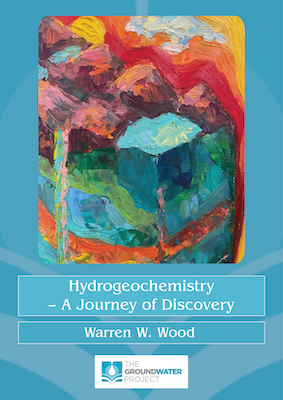Understanding the origin of geogenic solutes (dissolved chemical elements unaffected by human activity) in groundwater has broader implications than a traditional water resource investigation. Humans evolved over millions of years drinking water from springs and seeps within a narrow range of solute compositions and concentrations as did nearly all terrestrial animals, fish, and plants. Accordingly, it is incumbent upon us to sustain this critical solute balance as we utilize this resource. That is best achieved through knowledge of its origin and the mechanisms controlling its ionic concentration and composition. This monograph is written for those individuals who are seeking a conceptual understanding of groundwater geochemistry. The first four chapters are largely descriptive outlining basic geochemistry conceptually the last four chapters use basic mass balance techniques to evaluate potential sources of solutes and use the techniques to estimate physical aquifer properties.https://youtu.be/4mRFYIcDfgw
Hydrogeochemistry – A Journey of Discovery

Publication year: 2025
Number of pages: 262
978-1-77470-118-8
https://doi.org/10.62592/CBIQ7579
Citation:
Wood, W. W. (2025). Hydrogeochemistry – A journey of discovery. The Groundwater Project. https://doi.org/10.62592/VKTX1330.
Author:
Warren W. Wood, Michigan State University, USA
Please donate to support us in providing free high-quality education to the global groundwater community.
Thank you,
John Cherry
Description
Interview with the Author
Thank you for signing up to our email list!
Contents
1 REVIEW OF HYDROGEOCHEMICAL FUNDAMENTALS
1.1 Chemical Principals
1.2 The Origin of Elements and Their Atomic Structure
1.3 Groundwater Composition and Concentration of Solutes, Gasses, and Particulates
1.4 Water Isotopes
1.5 Collection of Groundwater Samples
1.6 Uncertainty
2 SOURCES AND MECHANISMS CONTROLLING SOLUTES
2.1 Advective Flow and Diffusion as Transport Mechanisms
2.2 External Solute Source: Precipitation, River, Lakes, and Contiguous Aquifers
2.3 Internal Solute Sources: Fossil, Relic, Legacy, or Connate
2.4 Internal Solute Source: Radioactive Decay
2.5 Internal Source of Solutes: Weathering
2.6 Equilibrium Variables
2.6.1 Mineral Solubility: A Fundamental Thermodynamic Property
2.6.2 Temperature: An Environmental Thermodynamic Property
2.6.3 pH: An Environmental Thermodynamic Property
2.6.4 Eh (Redox): An Environmental Thermodynamic Variable
2.6.5 Thermodynamic Activity: An Environmental Thermodynamic Property
2.6.6 Equilibrium Calculations
2.7 Kinetics of Precipitation
2.7.1 Cation Exchange and Adsorption
2.7.2 Adsorption — A Process of Removing Solutes
2.8 Hydrodynamic Dispersion in Transport
2.9 Solute Control in Open and Closed Systems
2.10 Ultrafiltration (Reverse Osmosis) as a Physical Control on Solutes
2.11 Section Wrap Up
3 GEOGENIC TRACE ELEMENTS RELATED TO HUMAN HEALTH
3.1 Manganese (Mn)
3.2 Arsenic (As)
3.3 Radionuclides of Uranium (U), Radium (Ra), Radon (Rn), Polonium (Po), and Lead (Pb)
3.4 Strontium (Sr)
3.5 Fluoride (F)
3.6 Molybdenum (Mo)
3.7 Lead (Pb)
3.8 Antimony (Sb)
3.9 Selenium (Se)
3.10 Zinc (Zn)
3.11 Lithium (Li)
3.12 Nuisance Elements
3.13 Iron (Fe)
3.14 Hydrogen Sulfide (H2S) and Methane (CH4)
3.15 Section Wrap-Up: Selected Trace Geogenic Elements
4 GRAPHICAL DISPLAY OF HYDROGEOCHEMICAL DATA
4.1 Principals of Graph Design
4.1.1 Heat Map
4.1.2 Contour Map
4.1.3 Fence Diagram
4.1.4 Cumulative Frequency
4.1.5 Box and Whisker Plot
4.1.6 Histogram
4.1.7 Pie Diagram
4.1.8 X–Y Linear Graph
4.1.9 Bar Diagram
4.1.10 Stacked Diagram
4.1.11 Trilinear Diagram
4.1.12 Stick Diagram
4.1.13 Stiff Diagram
4.1.14 Scholler Diagram
4.1.15 Durov Diagram
4.2 Section Wrap Up
5 FIELD EXAMPLES OF DIFFERENT HYDROGEOCHEMICAL SOURCES AND PROCESSES
5.1 Aquifer Solutes Dominated by Atmospheric Precipitation: The Southern High Plains Aquifer of Texas and New Mexico, USA
5.2 Aquifer Solute Dominated by Rock Weathering: Upper Grand River Basin, Central Michigan, USA
5.3 Aquifer Solutes Dominated by Ion Exchange: Atlantic Coastal Plain, USA
5.4 Aquifer Solutes Dominated by Elevated Ph: Blue Pools of the Sultanate of Oman
5.5 Aquifer Solutes Dominated by Low pH
5.6 Aquifer Solutes Impacted by Ultrafiltration: Saginaw Formation, Michigan, USA
5.7 Solutes Dominated by Loss of Gas to the Atmosphere: Nitrogen and Bromine from the Coastal Sabkha of Abu Dhabi, UAE
5.8 Radon-222: Solutes Dominated by Diffusion
5.9 Systems Dominated by Soil Salinization
5.10 Evaluating Pristine Condition
5.11 Section Wrap Up
6 SOLUTE MASS BALANCE: SIMPLE MASS FLUX MODELING
6.1 Representative Control Volume (RCV) Mass Flux Model
6.2 Pore Volumes
6.3 Mass Flux Modeling in the Sabkha of Abu Dhabi, UAE
6.4 Global Mass Flux Modeling of Carbon, Nitrogen, and Total Solutes
6.4.1 Carbon in Global Groundwater
6.4.2 Nitrogen in Global Groundwater
6.4.3 Groundwater Weathering of the Continents
6.5 SECTION WRAP UP 174
7 GEOCHEMICAL EVOLUTION OF GROUNDWATER SOLUTES
7.1 Evolution of Sulfate From Dissolution of Gypsum
7.2 Cation Exchange
7.3 Pyrite Oxidation
7.4 Molecular Diffusion in Solute Evolution
7.5 Groundwater and Evolution of Karst Topography
7.6 On Evolution of Global Groundwater Solutes
7.7 Section Wrap Up
8 QUANTIFYING PHYSICAL HYDROLOGIC PROPERTIES USING GEOGENIC SOLUTES
8.1 Model of The Regional Recharge Flux: The Chloride Mass Balance (CMB)
8.2 Estimates of Hydraulic Conductivity Using Chloride Mass Balance (CMB)
8.3 Runoff Flux to Topographic Features: Chloride Mass Balance (CMB)
8.4 Relative Groundwater Recharge as a Function of Geomorphology, Soils, or Land Use/Cover
8.5 Defining Macropore or Diffuse Recharge Using Stable Water Isotopes
8.6 Water Source of Paleo Recharge Using Stable Water Isotopes
8.7 Dating Groundwater With Carbon-14
8.8 Estimate of Recharge Flux and Rainfall from a Paleo Groundwater Surface: Liwa, UAE
8.9 Estimate of Active Global Groundwater Volume
9 WRAP UP
10 EXERCISES
11 REFERENCES
12 BOXES
Box 1 – Atomic Structure
Box 2 – Applying Activity Calculations to the Average Groundwater Composition
Box 3 – Instructions for Running Phreeqc on a MAC Laptop (Intel and Apple M Silicon Chip)
Box 4 – An Unexpected Journey in Hydrogeochemical Thinking
13 EXERCISE SOLUTIONS
14 NOTATIONS
15 ABOUT THE AUTHOR
Thank you for signing up to our email list!
